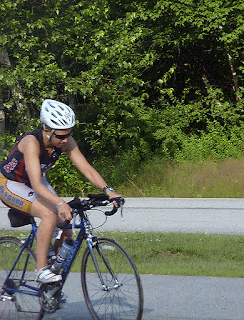 |
| I'm glad technology has advanced beyond this 25+ year old fully rigid bike with narrow wheels and handlebars, which I now use for commuting. |
Just a few days ago, Alex and I were going out for a ride close to our house, but the trail was all gross and buggy so we decided to do a skills day. I was on my full suspension and he was trying to teach me how to control the back end of the bike. But with all the squish from the rear suspension, I couldn't tell if I was doing anything right or wrong. So we went back to our house to switch bikes to my hardtail, and then I had a much better feel for all the drills.
My hard tail is so hard. Please excuse Alex's snort, he thought the video was silly (which it totally is!).
For a little over a year, I only rode my hardtail (the only mountain bike I had). Then Alex started dropping hints that it was about time to get me a full suspension, but I wasn't ready yet. I'd ridden on his and it felt like cheating (though really smooth and comfy). It floated effortlessly up and over roots, and I could fly down hills without worrying about all the chunky stuff. But before I switched to the comfort of the full squish, I wanted to make sure I had most of my basics down. Alex keeps telling me that if you can't ride something on a rigid frame, you have no business letting a full suspension bike get you through it. Full suspension lets you hit lines faster and with more comfort, but you shouldn't use suspension as a substitute for skills. It wasn't until after my first mountain bike race where I was one of the only people on a hardtail, getting passed by full suspension bikes that didn't have to slow down over super rooty sections, that I realized it was time. I wanted to go faster, but the jiggling of my brain going over roots was causing me to slow down. So when I found an awesome deal on a full suspension, we went for it!
My full suspension bike is so much squishier! Like a pogo stick.
I've had my full suspension for about 3 months now, and I love it! For riding somewhere as rooty as in the southeast, it makes the rides a lot nicer. And though it completely felt like cheating when I first was riding it, I'm really glad I got one. By learning the basics on a hardtail, I usually avoid letting rear suspension be a crutch. I'm still making similar line choices and shifting my weight around, but I have a little more freedom and comfort. I've kept my hardtail and continue to ride it for skills days because it's so much better to learn on - a rigid frame really tells you when you are being sloppy. Alex and I keep saying that we want to have hardtail days where we take them on the trails to make sure we're staying smooth and not relying on squish to carry us through obstacles. We'll do this one day when we remember...
Don't forget to like my new Facebook page to stay updated on new posts and other random mountain biking things! www.facebook.com/unexpectedmountainbiker






